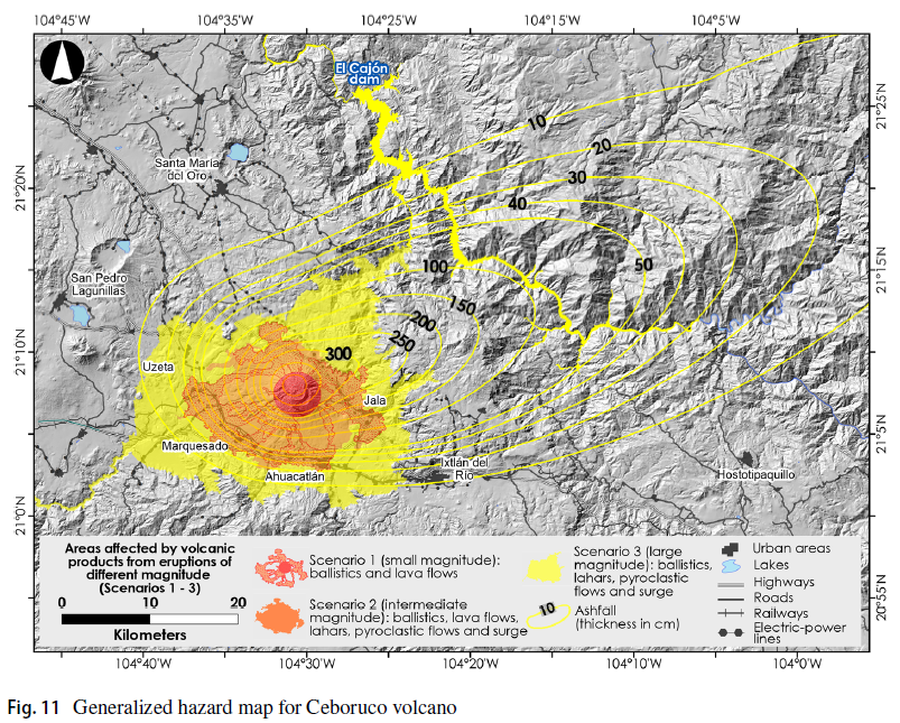Areas affected by volcanic products from eruptions of different magnitude (Scenarios 1-3)
Ceboruco, Mexico, 2019
Figure 11 in: Sieron, K., Ferrés, D., Siebe, C., Constantinescu, R., Capra, L., Connor, C., Connor, L., Groppelli, G. & Zuccolotto, K.G. (2019). Ceboruco hazard map: part II—modeling volcanic phenomena and construction of the general hazard map. Natural Hazards, 96(2), p. 893-933. https://doi.org/10.1007/s11069-019-03577-5
This hazard map is the result of scientific research and was published in academic literature.
It is presented here to serve as an example of the map type or the map-making methodology. It is NOT the official, operational map. For the current operational hazard map, please consult the proper institutional authorities.

Click on image for full-size map.
Map Set
Sieron, K., Ferrés, D., Siebe, C., Constantinescu, R., Capra, L., Connor, C., Connor, L., Groppelli, G. & Zuccolotto, K. G. (2019). Ceboruco hazard map: part II—modeling volcanic phenomena and construction of the general hazard map. Natural Hazards, 96(2), p. 893-933. https://doi.org/10.1007/s11069-019-03577-5
https://doi.org/10.1007/s11069-019-03577-5
Other Maps In Set:
- Ash fall hazard maps for different scenarios considered at Ceboruco volcano
- Hazard map for the emission of ballistics from Ceboruco volcano
- The hazard map for lava flows at Ceboruco volcano
- Hazard map considering pyroclastic flows at Ceboruco volcano
- Susceptibility map for lahar flooding
- Hazard map for scenario 1 (small magnitude and highest probability) showing the areas affected by lava flows and ash fallout
- Hazard map for scenario 2 (intermediate magnitude and probability of occurrence), showing the areas affected by ash fallout (N–NE) and the different types of flows: lava flows, PDCs, and lahars covering the entire surrounding valley
- Hazard map for scenario 3 (greatest magnitude and lowest likelihood)
Map Data
Map ID 1428 Hazard Process(es) Ballistics; Lahars; Lava flows; PDCs; Surges; Tephra fall Hazard Zone Presentation Hazard level-focused: All or most hazards are combined by hazard level on a main map panel Temporal Scale Background, or long-term, map Spatial Scale Volcano and surrounding area Publication Format Figure in a journal article Zonation Method(s) Probabilistic modeling; Scenario modeling Zonation Model(s) Eject! (Mastin 2001); Energy cone or line (Heim 1932; Sheridan 1979; Sheridan & Malin 1983); Etna Lava Flow Model (Damiani et al. 2006); FLO-2D (O'Brien 1993); HAZMAP (Macedonio et al. 2005); LAHARZ or modified version (such as PFZ) (Iverson et al. 1998; Schilling 1998; Schilling 2014); Tephra2 (Bonadonna et al. 2005; Bonadonna et al. 2010; Connor et al. 2011); TITAN2D (Pitman et al. 2003; Patra et al. 2005) Scenario(s) Considered Composition; Size, VEI, or intensity; Style or type Hazard Zone Label(s) Estimated value or Hazard Impact Metric; Scenario name Probability Definition(s) Scenarios imply probability Purpose Scientific interest: Intended for scientific research and general scientific interest; usually published in academic journals Audience Scientists (usually in scientific publication) Language(s) English Basemap(s) Hillshade Basemap overlay(s) Street map Diemsionality Planimetric (2D or map) view Color Scheme Red to Yellow
